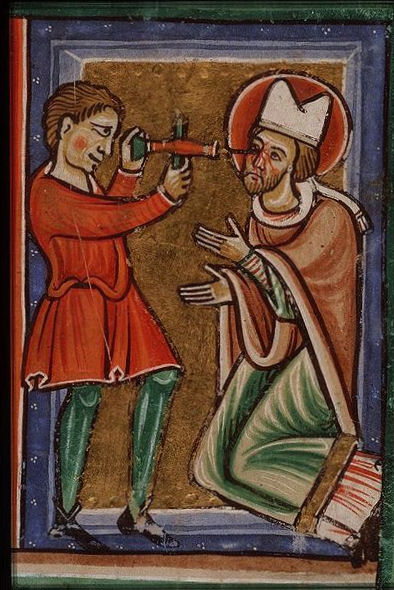St. Leodegar
(also Leger or Leodegarius)
 Bishop of Autun, born about 615; died a martyr in 678, at Sarcing, Somme.
Bishop of Autun, born about 615; died a martyr in 678, at Sarcing, Somme.
His mother was called Sigrada, and his father Bobilo. His parents being of high rank, his early childhood was passed at the court of Clotaire II.
He went later to Poitiers, to study under the guidance of his uncle, the bishop of that town. Having given proof of his learning and virtue, and feeling a liking for the priestly life, his uncle ordained him deacon, and associated him with himself in the government of the diocese. Shortly afterwards he became a priest and with the bishop’s approval withdrew to the monastery of St. Maxentius in 650. He was soon elected abbot and signalized himself by reforming the community and introducing the Rule of St. Benedict.

The martyrdom of St. Leger, Bishop of Autun: his eyes are pierced with a drill. From a picture Bible, circa 1200.
In 656 he was called to the court by the widowed Queen Bathildis to assist in the government of the kingdom and in the education of her children. In reward for his services he was named to the Bishopric of Autun in 610. He again undertook the work of reform and held a council at Autun in 661. It dealt a crushing blow to Manichæism and was the first to adopt the Creed of St. Athanasius. He made reforms among the secular clergy and the religious communities, and he impressed on all pastors the importance of preaching and of administering the sacraments, especially baptism. For this purpose the bishop had three baptisteries erected in the town. The church of Saint-Nazaire was enlarged and embellished, and a refuge established for the indigent. Leodegar also caused the public buildings to be repaired and the old Roman walls to be restored. The latter still exist and are among the finest specimens preserved.
 Serious trouble soon arose in the state. The Austrasians demanded a king and young Childeric II was sent to them through the influence of Ebroin, the mayor of the palace in Neustria. The latter was practically a ruler and desired to get rid of all who thwarted his plans. The queen withdrew from the court to an abbey she had founded at Chelles, near Paris. On the death of Clotaire III, in 670, Ebroin raised Thierry to the throne, but Leodegar and the other bishops supported the claims of his elder brother Childeric, who, by the help of the Austrasians and Burgundians, was eventually made king. Ebroin was exiled to Luxeuil and Thierry sent to St. Denis. Leodegar remained at court, guiding the young king. When the bishop protested against the marriage of Childeric and his first cousin, he also was sent to Luxeuil, his enemies representing him to the king as a conspirator. Childeric II was murdered at Bondi in 673, by a Frank whom he had maltreated. Thierry III now ascended the throne in Neustria, making Leudesius his mayor. Leodegar and Ebroin hastened from Luxeuil to the court. In a short time Ebroin caused Leudesius to be murdered and became mayor. He vowed vengeance on the bishop, whom he looked on as the cause of his imprisonment. About 675 the Duke of Champagne and the Bishops of Chalons and Valence stirred up by Ebroin, attacked Autun. To save the town, Leodegar surrendered to them. He was brutally treated and his eyes put out, the sockets being seared with red-hot irons. Ebroin’s bloodthirsty instincts were not yet satiated; he caused the holy bishop’s lips to be cut off and his tongue to be torn out. Some years later he persuaded the king that Childeric had been assassinated at the instigation of Leodegar. The bishop was seized again, and, after a mock trial, was degraded and condemned. He was led out into a forest by Ebroin’s order and murdered.
Serious trouble soon arose in the state. The Austrasians demanded a king and young Childeric II was sent to them through the influence of Ebroin, the mayor of the palace in Neustria. The latter was practically a ruler and desired to get rid of all who thwarted his plans. The queen withdrew from the court to an abbey she had founded at Chelles, near Paris. On the death of Clotaire III, in 670, Ebroin raised Thierry to the throne, but Leodegar and the other bishops supported the claims of his elder brother Childeric, who, by the help of the Austrasians and Burgundians, was eventually made king. Ebroin was exiled to Luxeuil and Thierry sent to St. Denis. Leodegar remained at court, guiding the young king. When the bishop protested against the marriage of Childeric and his first cousin, he also was sent to Luxeuil, his enemies representing him to the king as a conspirator. Childeric II was murdered at Bondi in 673, by a Frank whom he had maltreated. Thierry III now ascended the throne in Neustria, making Leudesius his mayor. Leodegar and Ebroin hastened from Luxeuil to the court. In a short time Ebroin caused Leudesius to be murdered and became mayor. He vowed vengeance on the bishop, whom he looked on as the cause of his imprisonment. About 675 the Duke of Champagne and the Bishops of Chalons and Valence stirred up by Ebroin, attacked Autun. To save the town, Leodegar surrendered to them. He was brutally treated and his eyes put out, the sockets being seared with red-hot irons. Ebroin’s bloodthirsty instincts were not yet satiated; he caused the holy bishop’s lips to be cut off and his tongue to be torn out. Some years later he persuaded the king that Childeric had been assassinated at the instigation of Leodegar. The bishop was seized again, and, after a mock trial, was degraded and condemned. He was led out into a forest by Ebroin’s order and murdered.
His testament drawn up at the time of the council as well as the Acts of the council, are preserved. A letter which he caused to be sent to his mother after his mutilation is likewise extant. His relics, which had been at Sarcing in Artois, were translated to the Abbey of St. Maxentius at Poitiers in 782. Later they were removed to Rennes and thence to Ebreuil, which place took the name of Saint-Léger. Some of them are still kept in the cathedral of Autun and the Grand Séminaire of Soissons. In 1458 Cardinal Rolin caused his feast day to be observed as a holiday of obligation.
PITRA, Histoire de Léger (Paris, 1846); BENNETT in Dict. Christ. Biog., s.v. Leodegarius; FAURIEL, Histoire de la Gaule méridionale, II (Paris 1836), 461-473; GUIZOT,Collection des mémoires relatifs ý l’histoire de France, II (Paris 1823), 325; GUŠRIN, Vie des saints, XI (Paris, 1880), 619-47; MABILLON, Acta SS. O.S.B., II (Paris. 1669), 680-705; P.L., XCVI, 377-84; CXIII, 373; CXXIV, 529; Analecta Bollandiana, XI (Brussels, 1892), 104-10; KAULEN in Kirchenlex., s.v.
A.A. MACERLEAN (Catholic Encyclopedia)






